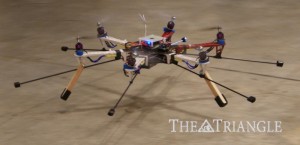Jan 19 2013
Richard Voyles, an associate professor of computer science at the University of Denver, visited Drexel University Jan. 11 as a part of Drexel’s Robotics Seminar Series: “Collaborative Mechatronics: Linking the Cyber, the Physical and the Human,” to discuss the developmental strategy and design process of search and rescue robots.
 Rescue Robot. Image courtesy of DU-Collaborative-Mechatronics-Lab
Rescue Robot. Image courtesy of DU-Collaborative-Mechatronics-Lab
“It’s very exciting seeing the intricacies of search and rescue,” Melvin Mathew, a graduate student studying mechanical engineering, said. “I’m always interested in coming to these types of events. It gives me a new perspective and ideas which I can use for my own designs.”
“Well, everyone, let’s take a look at some of the cool stuff we created,” Voyles said, opening up his lecture. “There are certain parameters one must adhere to when designing search-and-rescue robots. First, a robot has to be small enough to fit into the cracks and crevices of the rubble of a site. If the robot is too big, then your rescue capacity is next to useless.”
“Second, the robot must have a full range of motion, including lateral movement,” Voyles continued. “We were called out to the Crandall Canyon Mine collapse in 2007, and we deployed a packbot to search for the lost miners. Within two meters, our packbot became wedged in a rock both in front and behind. Since it couldn’t move laterally, we had to abandon it. Third, the designer must think about ease of operation. Oftentimes a fireman or search-and-rescue officer will be operating this robot on three hours of sleep with about an hour of previous robotics training. The controls have to be simple and efficient. Finally, the materials and cost have to be relatively inexpensive so if a robot is lost, … we [would] be able to rapidly [replace it].”
Voyles then talked about two different robot designs that the University of Denver was working on, the CRAWLER and the MOTHERSHIP. The CRAWLER is a limbed robot designed to crawl over and into debris. The robots are five meters, allowing them to navigate tight enclosures while simultaneously overcoming obstacles such as stairs.
“In fact, we actually have really cool videos of soldiers and aid workers throwing the robots out a two-story window in their downtime and having the robot crawl back to them,” Voyles said.
“Next, the MOTHERSHIP is a tread-lined robot built to roll over long passageways,” Voyles continued. “This robot is perfect for traveling along long passages, such as mine tunnels, and not becoming diverted off course by the wreckage.”